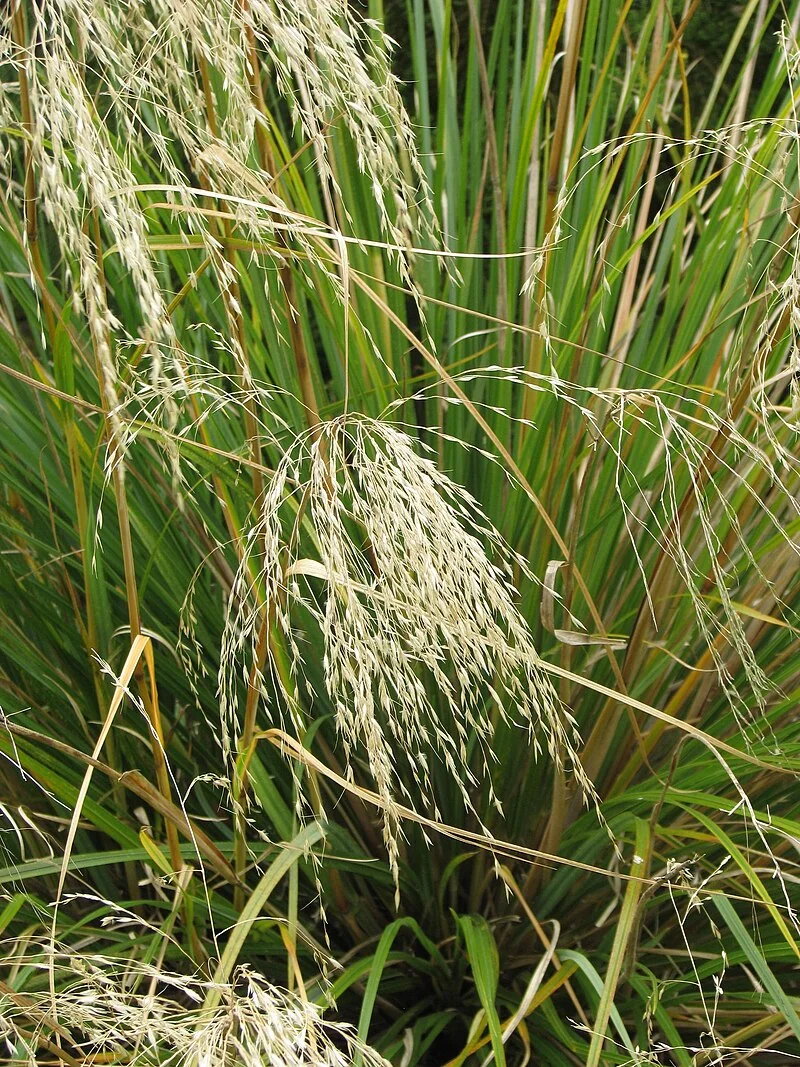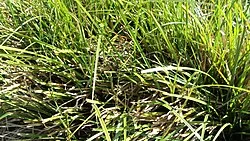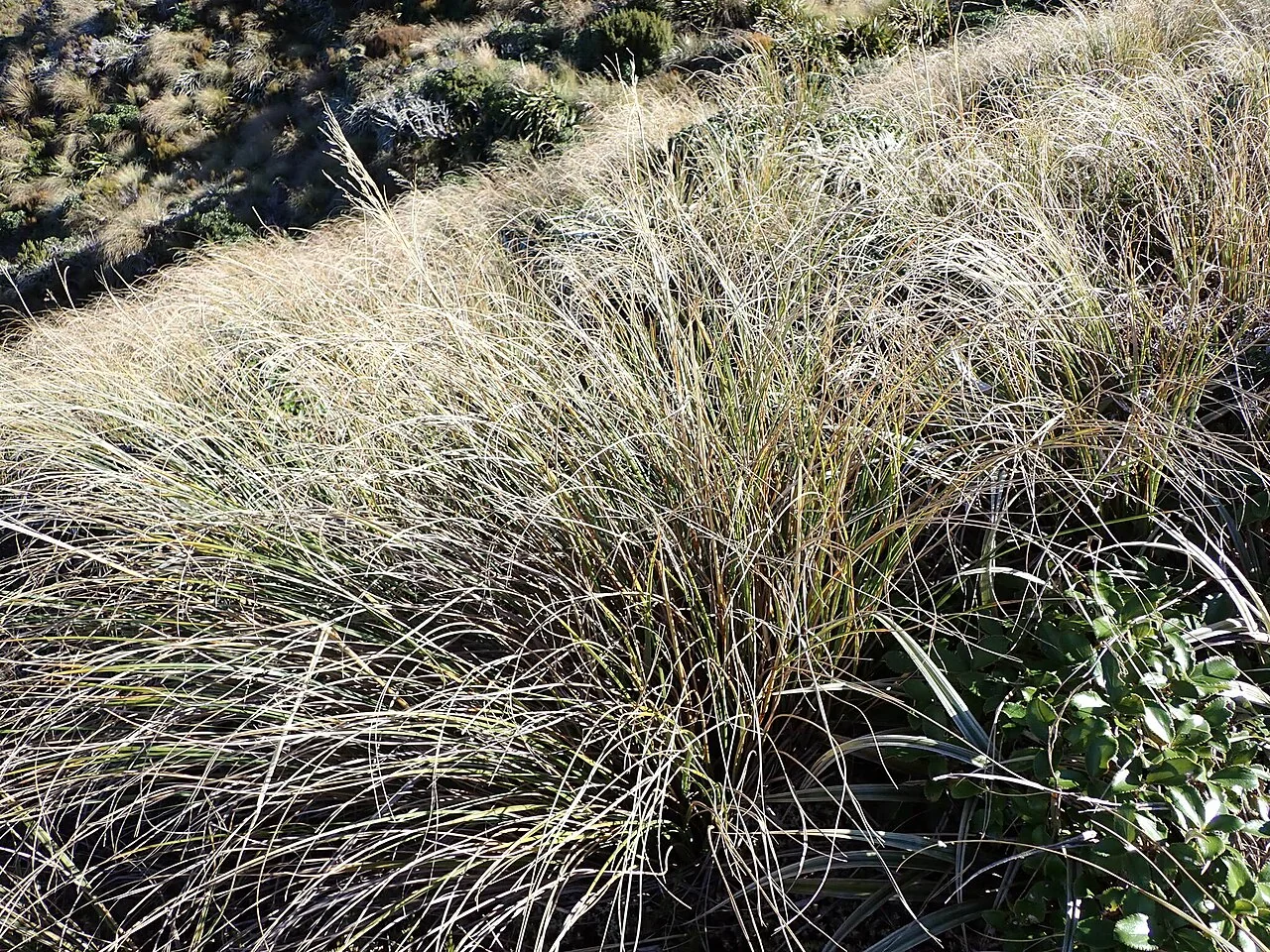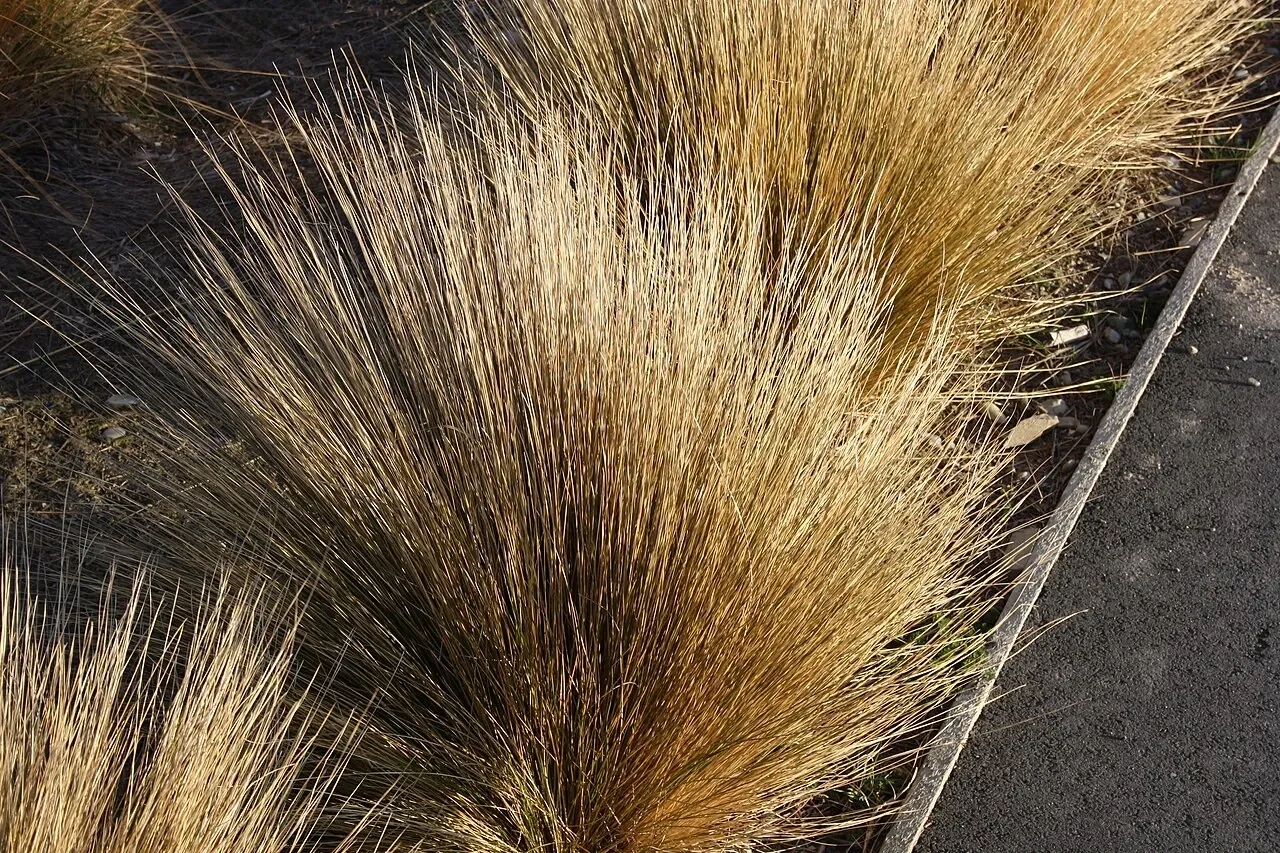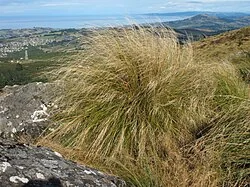
Stiff Snow Tussock
Chionochloa rigida
Chionochloa rigida ( Chionochloa rigida ) is a native New Zealand plant. More information about this species will be added soon. Learn more about grasses .

Plant Description
Chionochloa rigida (narrow‑leaved snow tussock) forms dense, fine‑textured tussocks with tall, elegant flowering stems that sway in wind. A defining grass of South Island uplands.
Quick Facts
| Scientific Name | Chionochloa Rigida |
|---|---|
| Common Name | Stiff Snow Tussock, Narrow-leaved Snow Tussock |
| Plant Type | Perennial tussock grass |
| Height | 60-90cm (foliage), flowering stems to 1.5 m |
| Spread | 60-120cm diameter when mature |
| Leaves | Narrow, stiff, blue-green to bronze, inrolled |
| Flowers | Pale golden panicles in summer (December-February) |
| Fruit | Small seeds with feathery awns |
| Habitat | Subalpine tussocklands, eastern South Island high country |
| Uses | Alpine gardens, slope stabilization, naturalistic landscaping |
| Water Needs | Low - drought tolerant once established |
| Light | Full sun essential |
| Frost Tolerance | Extremely hardy - tolerates -15°C and below |
| Soil | Free-draining, low fertility, stony or sandy |
| Growth Rate | Slow - takes 3-5 years to form substantial tussock |
| Salt Tolerance | Low - not suited to coastal salt spray |
| Lifespan | Long-lived perennial (decades in suitable conditions) |
Climate Best Suited to
Cool, dry temperate to subalpine climates; very frost and wind hardy; demands free- free‑draining, low‑fertility soils.
Regional Suitability
| City | Climate Suitability |
|---|---|
| Whangārei | Ideal |
| Auckland | Challenging |
| Hamilton | Ideal |
| Tauranga | Ideal |
| Rotorua | Ideal |
| Gisborne | Ideal |
| New Plymouth | Ideal |
| Napier | Ideal |
| Whanganui | Ideal |
| Palmerston North | Ideal |
| Wellington | Ideal |
| Nelson | Ideal |
| Christchurch | Ideal |
| Dunedin | Ideal |
| Invercargill | Ideal |
Natural Habitat
Upland slopes and basins of Otago and Canterbury in full sun and exposure.
Across the eastern South Island high country, Stiff Snow Tussock dominates windswept ranges, outwash terraces and stony glacial soils. It occupies lean, rapidly draining substrates where winter snow, intense UV and desiccating nor'westers select for tightly folded, durable leaves and deep, binding roots that stabilise slopes and intercept rare moisture pulses.
Plant Conservation
Locally common within suitable habitat; vulnerable to land-use change.
Retaining intact, unfertilised tussockland and limiting frequent burning are central to conserving populations. Weed control on colder fans and ridge crests prevents woody ingress and preserves the open, low-fertility conditions that snow tussocks require to regenerate.
How to Grow
Planting Guide
Best Planting Practices
Plant on slopes or raised beds; avoid fertiliser and waterlogging; space 1-1.5 m for mature mounds.
Build a mound or scree bed of coarse gravel and sharp sand over free-draining subsoil; set crowns slightly high to shed water. After planting, soak thoroughly to settle. In very windy sites, pin with discreet pegs until rooted. Do not enrich; lean conditions maintain tight texture and longevity.
Ecology
Provides structure and habitat for skinks and invertebrates; important in high-country ecosystems.
Large tussocks trap snow and harvest fog, funnelling moisture to roots and adjacent plants. The persistent thatch provides thermal refuges for alpine invertebrates and cover for lizards; periodic mast flowering sustains seed-eating birds and invertebrates in the leanest seasons.
Uses
Feature tussock and dry meadow matrix; slope stabiliser in lean soils.
Use as the backbone of naturalistic dry meadows, to knit scree gardens and stabilise sunny banks. Its bronze winter tones and luminous seed heads lend drama when backlit; set as solitary domes or sweeping drifts to read the South Island high-country character.
Landscaping Ideas
Group with divaricating shrubs and alpine hebes for a high-country palette.
Backlight the planting with a westward aspect so the airy panicles glow at dusk. Interplant with slabs of schist or greywacke to echo the natural geology and to warm the root zone in spring without increasing soil fertility.
Seasonal Care
Late Winter
Comb out thatch; avoid hard shearing.
Spring
Spot-weed carefully and water deeply after dry winters to drive root growth; do not fertilise.
Pruning
Pruning Techniques
Remove old flower stems and lightly comb foliage annually.
Avoid cutting into live foliage domes; instead tease dead material free by hand or with a rake. This preserves the fountain form and prevents patchy regrowth.
How to Grow Stiff Snow Tussock
Stiff Snow Tussock thrives when you replicate its natural subalpine habitat conditions, demanding excellent drainage, lean soil fertility, and full sun exposure to develop its characteristic tight, resilient form. This iconic high-country grass requires specific establishment techniques to succeed in cultivation, as it evolved in harsh mountain environments with intense UV exposure, strong winds, and extreme temperature fluctuations that have shaped its unique growth requirements and adaptation strategies.
Site Preparation and Planting
Create well-draining planting sites by constructing raised beds or mounded areas using a mix of coarse sand, fine gravel, and decomposed granite or similar mineral-based growing medium. Avoid rich, moisture-retentive soils that promote soft growth vulnerable to fungal diseases and winter damage. Dig wide planting holes at least three times the root ball diameter, incorporating additional drainage material if necessary. Position the crown exactly at the original soil level or slightly proud to ensure water sheds away from the base, preventing crown rot that frequently kills tussocks in unsuitable conditions.
Seed Propagation
Collect fresh seed from mature panicles during late summer when seeds are fully ripe but before natural dispersal begins. Sow immediately on a free-draining propagation mix combining equal parts coarse sand, perlite, and quality seed-raising compost. Cover seeds lightly with fine horticultural grit to maintain surface moisture while preventing seed burial. Maintain consistent moisture without waterlogging, providing bright indirect light until germination occurs, typically within 2-6 weeks depending on seed viability and temperature conditions. Transplant seedlings individually into deep containers once root systems develop adequately to support the young plants through their vulnerable establishment phase.
Division and Establishment Care
Mature clumps can be carefully divided in early spring as new growth emerges, ensuring each division retains several growing points and adequate root material for successful re-establishment. Replant divisions immediately into prepared sites, watering thoroughly to eliminate air pockets around roots while avoiding waterlogged conditions. Mulch lightly with coarse organic matter such as pine bark chips, maintaining a clear zone around the crown to prevent moisture accumulation that can lead to fungal problems. Avoid fertilization during the first season, allowing natural establishment processes to develop the deep root system essential for long-term survival in lean conditions.
Pests and Diseases
Common Problems and Solutions
Generally pest-free; crown rot in poorly drained sites.
Excessive summer irrigation or organic mulches that hold moisture against the crown shorten lifespan. Keep the base open and dry, irrigating deeply but rarely only during extended drought in the first season.
Cultural Significance
Traditional Uses and Values
Snow tussocks define South Island upland landscapes and are central to their identity.
They are emblematic of high-country stations and conservation estates alike, signalling intact alpine processes; retaining their bronze tussock cover preserves the distinctive sense of place that draws visitors and sustains local stewardship.
Bonus Tip
Expert Growing Advice
Lean soils and exposure produce the tightest domes and longevity.
Where rainfall is high, plant on ridges or mounded screes; in drier districts, site to capture evening backlight so the seed heads ignite and the planting reads dramatically through summer and autumn.

